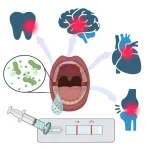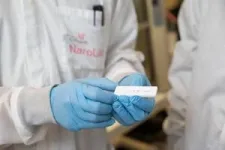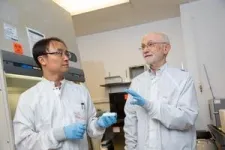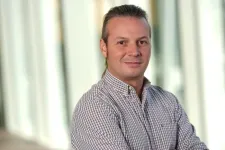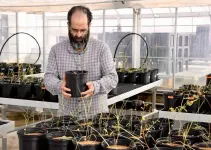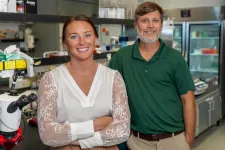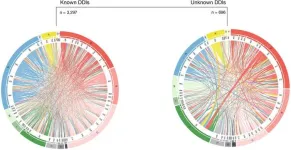(Press-News.org) Engineers at the University of Cincinnati have developed a new device that can warn consumers about early risks of tooth decay from diseases such as gingivitis and periodontitis.
Gingivitis, the earliest form of gum disease, is caused by bacteria. But not just any bacteria.
The problem for researchers was getting a device to single out the particular type responsible for the disease, said Andrew Steckl, an Ohio Eminent Scholar and distinguished research professor in UC’s College of Engineering and Applied Science.
“It’s been quite the challenge to get to the point where we can detect this toxin created by the bacteria responsible for gingivitis,” he said.
Steckl and UC Senior Research Associate Daewoo Han collaborated with Sancai Xie, a principal scientist at Procter & Gamble Co., and described their results in a paper published in the Royal Society of Chemistry journal Sensors and Diagnostics.
Steckl’s research team has been exploring biosensing for various applications. They studied stress hormones in sweat in collaboration with the Air Force Research Lab at Wright-Patterson Air Force Base. Now they are studying saliva.
“There are good reasons to use saliva,” he said. “It’s relatively plentiful and easy to obtain through noninvasive methods. And saliva has a lot of important elements that can act as indicators of your health.”
Bacteria from gingivitis can travel through the bloodstream, leading to cardiovascular disease and other serious health problems, Steckl said.
But saliva is a complicated biofluid, said Han, the study's lead author.
Researchers pretreated the sample using potato starch to remove a protein called amylase that could interfere with the test results. Their test uses antibodies that react to the endotoxins found in the bacteria.
“Daewoo worked very hard on many dead-ends before he had success,” Steckl said. “I tell my students that research is search, search and re-search until you find the answer.”
At-home health testing has been available for generations in niche uses such as detecting pregnancy. But the COVID-19 pandemic introduced a wide audience of consumers to the concept of monitoring their health with new technology.
The at-home testing industry is expected to generate $45 billion annually by 2031, according to Allied Market Research.
Steckl said he sees a lot of opportunity for new consumer products.
“Our results definitely show promise,” Steckl said. “Sometimes it comes easy. Most of the time you have to persevere.”
END
New at-home test for gingivitis protects oral health
Engineers create home test that uses saliva to detect periodontal disease
2023-09-07
ELSE PRESS RELEASES FROM THIS DATE:
Internationally recognized computational researcher Spyridon Bakas, PhD, to serve as inaugural director of Division of Computational Pathology
2023-09-07
INDIANAPOLIS—Indiana University School of Medicine Department of Pathology is launching a new Division of Computational Pathology and a Research Center for Federated Learning in Precision Medicine. Both will be led by Spyridon Bakas, PhD, an internationally recognized computational researcher who brings ten years of experience and NIH grant funding to this growing field that combines artificial intelligence and medicine.
“Computational pathology is a growing area of medicine around the world,” Bakas said. “The idea is to leverage information that exists within tissue slides ...
Two in one: FSU researchers develop polymer that can be adapted to high and low temperature extremes
2023-09-07
The modern world is filled with synthetic polymers, long-chained molecules designed by scientists to fill all manner of applications.
Researchers at FAMU-FSU College of Engineering have developed two closely related polymers that respond differently to high and low temperature thresholds, despite their similar design. The polymer pair could be used in applications in medicine, protein synthesis, protective coatings and other fields. Their work is published in Macromolecules.
“Typically, in order to have one thermal behavior, we have to prepare a polymer for that specific application, and if you ...
New stroke treatment in development at UTHSC
2023-09-07
A study at the University of Tennessee Health Science Center aims to develop a new way to treat ischemic stroke, a leading cause of death in adults worldwide.
The study is funded by a $1,155,000 translational grant from the National Institute of Neurological Disorders and Stroke, part of the National Institutes of Health. Jianxiong Jiang, PhD, associate professor in the Department of Pharmaceutical Sciences and the Department of Anatomy and Neurobiology, and Jiawang Liu, PhD, director of the Medicinal Chemistry ...
New study reveals the power of railroads to buffer coal plants from a carbon emissions tax
2023-09-07
A new study by University of Maryland Economist Louis Preonas provides empirical evidence that railroads are likely to cut transportation prices to prop up coal-fired plants if U.S. climate policies further disadvantage coal in favor of less carbon-intensive energy sources.
One strategy being considered to help reduce the country’s contribution to global climate change is a tax or fee on greenhouse gas emissions by coal-burning power plants. The hope is that such fees will reduce competitiveness of coal-fired energy and consumers will chose lower-emission options at a competitive cost. The new study, published September 7, 2023, in The ...
Mount Sinai scientists unlock secrets of red blood cell transporter, potentially paving the way for new drugs
2023-09-07
New York, NY (September 7, 2023)—Researchers at the Icahn School of Medicine at Mount Sinai have identified the structure of a special transporter found in red blood cells and how it interacts with drugs. Details on the findings, which were reported in the September 7 issue of Nature Structural & Molecular Biology [DOI: 10.1038/s41594-023-01085-6], could lead to the development of more targeted medicines.
The research team, led by Daniel Wacker, PhD, Bin Zhang, PhD, and Avner Schlessinger, PhD, found that this transporter facilitates ...
Research spotlight: History of Adverse Childhood Events (ACEs) linked to increased risk of head or neck injury and concussion
2023-09-07
Altaf Saadi, MD, MSc, principal investigator of the Neurodisparities & Health Justice Lab in the Department of Neurology at Mass General and an assistant professor of Neurology at Harvard Medical School, is lead author of a new study in the Journal of Head Trauma and Rehabilitation, Examining the Association Between Adverse Childhood Experiences and Lifetime History of Head or Neck Injury or Concussion in Children From the United States.
What Question Were You Investigating?
Is there an association between adverse childhood experiences ...
University of Houston researcher aids in creation of groundbreaking report on invasive species
2023-09-07
A new report by the Intergovernmental Platform on Biodiversity and Ecosystem Services (IPBES) presents major findings on the gravity of impacts from invasive alien species on our planet. Researchers found more than 37,000 alien species have been introduced by human activities over the centuries, and this conservative estimate is rising at unprecedented rates. Additionally, more than 3,500 of these are harmful invasive alien species, impacting humans, animals and plants.
Dozens of international biodiversity ...
CAR-T-cell therapy without side effects? Hollings researchers show results in preclinical models
2023-09-07
When Richard O’Neil, Ph.D., joined MUSC Hollings Cancer Center two years ago, he knew that he wanted to continue finding ways to make CAR-T-cell therapy easier on patients.
What he didn’t expect was that a side project – worked on by Megan Tennant, a graduate student in his lab, as a way to keep busy while a key piece of equipment was being serviced – would potentially open up this treatment beyond the world of cancer.
“I don't think that either of us expected that first initial experiment to work,” Tennant said. “But when we saw how well it worked and really started to conceptualize where this could go and how important ...
The timing of fireworks-caused wildfire ignitions during the 4th of July holiday season
2023-09-07
Every year on the 4th of July, fireworks cause cause a precipitous increase of wildfire ignitions in the United States (U.S.). This human-environmental phenomenon is noteworthy and highlights the impact of American culture on wildfire activity in the U.S. In other regions of the world, research has increasingly shown that human culture impacts fire activity, with weekly cycles of fire activity reflecting the local structures of workweeks and the timing of religious days of rest (e.g., Saturdays and Sundays). Although 4th of July peak in wildfire igntions has ...
Dosage tweaks may hint at undiscovered interactions between medications
2023-09-07
Analysis of data from more than 1 million Danish inpatients identifies nearly 4,000 drug pairings that are associated with more frequent dosage adjustments when prescribed together—potentially hinting at previously undiscovered drug interactions. Søren Brunak of the University of Copenhagen, Denmark, and colleagues present these findings in the open-access journal PLOS Digital Health.
In some cases, especially among elderly populations, a person may be prescribed several different medications at once in order to treat one or multiple health conditions—a phenomenon known as polypharmacy. Polypharmacy is associated with increased health risks due to the potential ...
LAST 30 PRESS RELEASES:
Do hormones explain why women experience more gut pain?
New materials conduct ions in solids as easily as in liquids
Breakthrough of the Year: Renewable energy begins to eclipse fossil fuel-based sources
LLM use is reshaping scientific enterprise by increasing output, reducing quality and more
Introducing LightGen, a chip for ultra-fast, ultra-efficient generative AI
Astronomers see fireworks from violent collisions around nearby star
ACC/AHA issue new guideline on managing congenital heart disease in adults
Cosmic crash caught on camera
Is talented youth nurtured the wrong way? New study shows: top performers develop differently than assumed
Ants: An untapped resource in the development of antibiotics?
Archaeologists use AI to create prehistoric video game
Mitochondria migrate toward the cell membrane in response to high glucose levels
Tiny viral switch offers hope against drug-resistant bacteria
Most parents aware of early peanut introduction guidelines, but confused about details
HPV vaccine can protect against severe lesions of the vulva and vagina
Virtual care provision and emergency department use among children and youth
Quadrivalent HPV vaccine and high-grade vulvovaginal lesions
Insights into dry eyes gained from stem cell-derived tear glands
Researchers identify 166 human pluripotent stem cell lines available for use in clinical applications
Europa Clipper instrument uniquely observed interstellar comet 3I/ATLAS
UN University Report challenges climate change as sole trigger of Syrian Civil War, exposing governance failures in drought response
Real estate investment trust (REIT) acquisition associated with hospital closure and bankruptcy
New Raman imaging system detects subtle tumor signals
Boston Children’s receives a $7.5 million grant from Aligning Research to Impact Autism (ARIA) to provide clinical research coordination for the IMPACT Network
Spray-on antibacterial coating offers new protection for plants against disease and drought
ESMT Berlin study: What makes a first offer successful in negotiations
Groundbreaking ceremony marks the beginning of CTAO-South Array construction in Chile
Why swearing makes you stronger
What prevents more cancer patients from enrolling in potentially life-saving clinical trials?
UK’s worst-case climate risks laid bare for lawmakers
[Press-News.org] New at-home test for gingivitis protects oral healthEngineers create home test that uses saliva to detect periodontal disease
